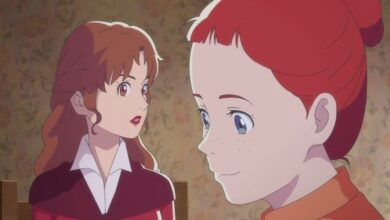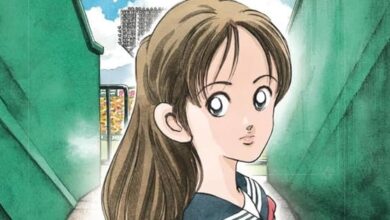Global Anime Challenge Unites Industry Veterans to Mentor Aspiring Animators and Tackle Crunch Culture for a Healthier Future

At Anime Central 2025, Anime News Network sat down with four of Japan’s rising anime talents—director Keiichirō Saitō (Frieren: Beyond Journey’s End, Bocchi the Rock!), producer Takafumi Nakame (The Garden of Words, your name.), and animators Kaoru Tanimoto (The Elusive Samurai, Sengoku Youko) and Mana Kudō (My Happy Marriage, Made in Abyss)—who were in Chicago for the Global Anime Challenge, a government-supported initiative designed to nurture the next generation of anime creators.
During a candid conversation, the guests, along with publicity coordinator Hiromi Hasegawa, shared their thoughts on the changing landscape of the anime industry, discussing the pressures of production crunch, the ongoing dialogue about unionization, and the lessons they wish they had learned before entering the field to aspiring animators about creative resilience, self-care, and establishing a sustainable future for anime both in Japan and overseas.
What inspired the creation of the Global Anime Challenge?
Hiromi Hasegawa: Hello, my name is Hiromi Hasegawa, and I’m the project sub-leader and English trainer for the Global Anime Challenge project. I’ve been working with Kinema Citrus (Made in Abyss, The Rising of The Shield Hero, Goodbye, Lara) for many years now. The creation of GAC was part of the Japanese government’s initiative to help grow and sustain Japanese anime production and culture as the country’s key industry, which can be exported outside the country by nurturing the young generation of talent. Muneki Ogasawara-san (GAC project leader, Kinema Citrus chairman), Yosuke Yasui-san (GAC facilitator, Japan Research Institute researcher), and I constitute the core of the GAC project; hence, we are the “core” members. We were busy right before attending Anime Central last year, filling out the application form to submit to the Agency for Cultural Affairs to get approved for the funding.
Fortunately, we got accepted and thus began our three-year journey into the unknown, as this type of project has never been done before. So the GAC participants are truly the pioneers, experiencing and experimenting with the idea of “step out to inspire the creative.”
What kind of support does the Japanese Agency for Cultural Affairs provide to
participants?
HASEGAWA: Actually, we are pretty independent in terms of what goals we set and what kind of activities we engage in. We do, of course, receive support from the Agency. We submit our plans beforehand, and they approve. When they do, they can point out what things will be necessary and also introduce us to the people and organizations that might help us. In that regard, we really appreciate this whole project being a government or national initiative.
What insights have you gained from engaging with international anime fans at Anime Central? Have conversations with attendees shaped your perspective on the anime industry as both a global art form and a field that creators and fans alike are eager to contribute to and celebrate?
Takafumi Nakame: What impressed me most at Anime Central is that the people seemed to be having so much fun attending the con. Seeing them being happy made me smile, too. The con had not only panels and autograph sessions, but DJ club events at night, too. Many attendees came and enjoyed these events immensely. This type of event is rarely seen in Japan, so it was a fresh experience for me, and I enjoyed ACen quite a lot. Hundreds of people came to our panel and autograph sessions. I was really grateful for that, and it was wonderful.
At the same time, I wondered, “How many anime fans are out there in the United States as a whole?” and “Would it be possible for us to reach even more people?” I think these questions are in relation to the potential of anime we create, leading to our future goals. As in Japan, many fans focus on anime works themselves. So if domestic and international fans pay more attention to the creators, then we can cultivate the anime culture more deeply and spread it even further.
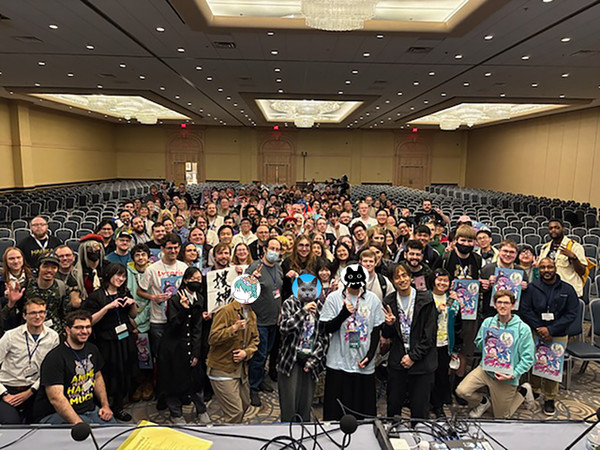
Keiichirō Saitō: Every time I attend a U.S. anime convention, I am always amazed by the fans’ enthusiasm as well as the scale of the event. I feel very blessed to be warmly welcomed into the community. The next thing that catches my eye is the cosplay culture, particularly its wide variety of costumes. I feel cosplay is enjoyed more openly in the U.S. than in Japan. While we enjoy observing each cosplayer’s individuality, I feel it is also a good opportunity for us to learn about current trends and popularity shifts in the U.S.
Mana Kudō: I felt that the fans watch anime much more enthusiastically than I had imagined. I was very much encouraged by the reactions and comments of those who came to our panel.
Kaoru Tanimoto: Through my experience at Anime Central, I saw firsthand how much Japanese anime is loved worldwide. I met people who shared the passion for anime, transcending language and cultural barriers – a truly memorable experience. The con site felt like a condensed space with an atmosphere reminiscent of anime shop areas in Akihabara or Ueno. It had this overwhelming energy, but at the same time, I was excited for that. I was actually at the nighttime DJ event, and when the theme song from Naruto played, the entire venue erupted in excitement. As someone from the Naruto generation, I felt a strong connection and was amazed and delighted to realize that this emotion could be shared across borders.
I also saw some local fans playing and enjoying music on their smartphones. The music was something popular on Japanese social media. It made me realize that we are truly living in an era where the world is connected in real time. I witnessed trends spreading globally. I would never have encountered this if I had lived solely in Japan.
Furthermore, I experienced some cultural differences. We played some simple games at our panel [like quiz games and janken]. Japanese fans tend to participate in such games quietly and timidly, being mindful of those around them. In contrast, Chicago fans reacted with loud cheers and seemed to enjoy the games proactively. While these contrasts in attitude made me feel the differences in our cultures and values, I also realized that I should express myself more freely.
Through this event, I was able to experience the influence my work and anime culture bring across borders and my strong connection with the world.
What kind of projects do you hope will emerge from the program?
NAKAME: Many Japanese anime series are based on manga, and fans tend to focus on these source materials. This is not necessarily a bad thing. I think it’s important to enjoy the title itself first and foremost. Yet at the same time, there are still only a few fans of original anime and their creators. I would be happy if more people unfamiliar with anime could appreciate the medium as a form of entertainment, just like they do when watching dramas and movies. I also hope the number of core anime fans increases.
Through GAC, we plan to produce pilot films (or concept trailers). As a preliminary step, GAC participants learn about and discuss, “How do I plan an anime project?” Through these talks, we will be able to consider the current status of the anime industry from multiple angles, adding new perspectives to each of our projects. Many overseas creators have already gathered in Japan to participate in 2D anime production, which is wonderful. There is also an increasing number of collaborations with overseas studios. We hope the GAC will serve as a catalyst, further expanding global connections.
SAITŌ: I’m not sure yet, but I hope that something different will emerge compared to the projects supported by the Agency for Cultural Affairs, such as Project A and Anime Mirai. GAC feels unique to me because young creators are put in charge of planning and coming up with ideas for their own anime projects.
KUDŌ: I would like to collaborate with creators outside Japan to create works in new styles. Even creators interested in overseas anime production are often too busy with their daily work to find time to travel abroad or study English, so I think GAC can help in that regard.
TANIMOTO: Preparations for overseas GAC activities are underway. For example, there are plans for trips and study abroad programs. I feel that the possibilities are expanding immensely. Currently, the project information is disseminated from Japan to overseas. From here on, however, we expect to receive more inquiries from abroad. We foresee the potential for more collaborative and interactive projects, such as joint productions with overseas studios.
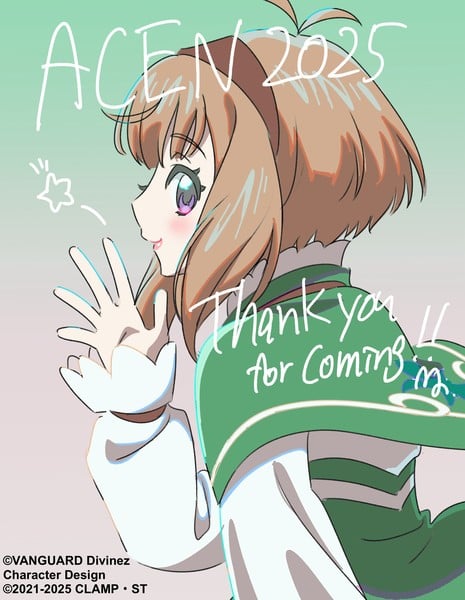 ©VANGUARD Divinez, Character Design ©2021-2025 CLAMP ST |
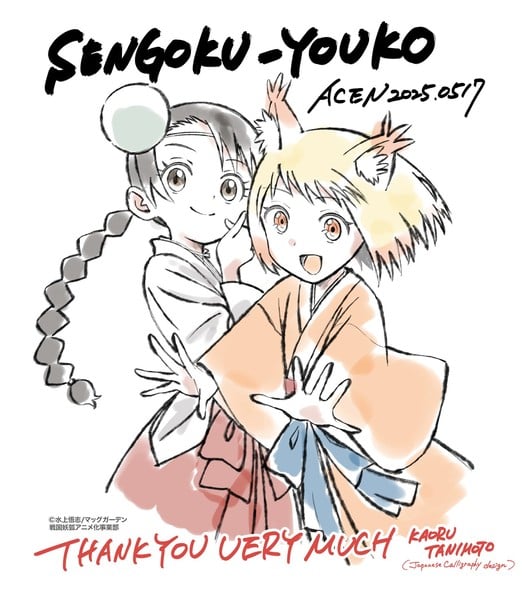 ©水上悟志/マッグガーデン・戦国妖狐アニメ化事業部 |
 © はまじあき/芳文社・アニプレックス |
What are some of the biggest challenges young anime creators face today, and how does this program help them overcome those hurdles?
NAKAME: The industry has always had a reputation for low wages and long hours. Although there have been some improvements in recent years, the situation is still not as good as in other industries. Honestly, I don’t foresee much improvement under the current structure. These improvements could also lead to increased commercialism and loss of freedom. I am concerned about an atmosphere that makes it difficult to dream and produce creative works. The GAC project cannot directly solve these issues. However, we can propose production pipelines and revenue models through GAC that do not put creators at a disadvantage. If GAC can inspire the creators and their works, providing some sense of hope, this could positively influence the work environment and goals of young animators in the future.
Although this may be difficult to achieve, if anime works can be created based on new values and spread throughout society, this could potentially lead to changes in the industry structure.
SAITŌ: Regarding financial and salary aspects, the budget increase for TV anime over the past few years has gradually improved the treatment of rookie animators at major studios. However, there are still studios where this is not the case. So I feel there is a growing divide or polarization.
What concerns me is that the anime industry as a whole relies heavily on source materials or IPs that are massively popular. Also, many young creators may have to adapt to working with highly complex character designs and animation techniques before fully grasping the more fundamental creative aspects and the real joy of animating.
I am unsure if GAC will be able to address this issue, but I believe the project respects each member’s individual efforts. Hence, I intend to keep thinking about this issue myself.
Have you personally experienced burnout working in the anime industry, and if so, what contributed to it?
NAKAME: I don’t think I’ve ever experienced burnout. Of course, I sometimes feel like taking a long break after finishing a challenging project. Yet after a while, I start feeling like I want to create something new again. In that sense, I may be well suited to the creative industry, such as animation.
SAITŌ: Yes, I have. Ever since Frieren ended, I haven’t been able to work how I used to. I think this is a response to being relieved of the pressure to adapt a popular manga into a commercially successful anime.
In the West, there’ve been instances where fans have seen Japanese animators take to social media to highlight harsh working conditions, particularly in the production of popular shonen anime. Has this kind of public discourse influenced the industry in Japan? Do you think the Western perspective on anime labor conditions is an unfair “armchair” read, or does it accurately reflect the challenges Japanese animators face? What changes would you like to see in the industry to create a healthier work environment for veterans and newcomers alike?
NAKAME: The working conditions in the anime industry have become a hot topic on social media, drawing attention from people outside the industry. The fact that such questions are being raised is a sign of the influence of social media.
From a compliance standpoint, studios and companies can no longer ignore these voices. Undoubtedly, this is having a certain impact on the Japanese anime industry. However, whether this is working positively is another matter. The industry’s problems are structurally deeply rooted and cannot be solved in the short term. Addressing the issues superficially could have a negative impact.
Many of the issues spoken about on social media are based on personal experiences. In some cases, the individuals themselves are sometimes at fault. Relying solely on one-sided claims in online discussions can be risky. That said, while each studio has its own circumstances, I feel that there are many common long-term challenges across the industry as a whole.
SAITŌ: I believe that what everyone is picking up on social media is true, yet at the same time, it represents only one side of the whole story. Such voices are prominent among the production sites of anime adaptations of popular shonen manga, because the creators who work on these titles are in the limelight. I often feel that the concerns and statements voiced contain nuances beneficial to the speaker.
A more serious issue is the struggles faced by those not in the spotlight, whose voices go unheard. As the industrial and consumption-oriented aspect grows stronger, and as long as talents are brought into the anime industry on an ad-hoc basis, these issues will persist. What’s more important is whether the industry and society as a whole can respect individual creators. However, there is also the challenge of whether creators can mature into responsible members of society.
How do anime studios typically manage production schedules to prevent crunch? How do smaller anime studios compare to larger ones in terms of workload and crunch culture? How do international collaborations impact production schedules and working conditions? Have there been any recent efforts to improve the working conditions of animators and production staff?
NAKAME: Many studios seem to be striving to stabilize their production schedules by promoting in-house production or collaborating with other studios. For instance, there is a growing trend of hiring freelancers and converting them to full-time employees.
In the past, many companies believed they had no room for human resources development. However, driven by the realization of urgency that “without nurturing proper talents, projects cannot be completed,” companies are increasingly prioritizing HR development. This is a positive change in itself.
While the number of staff a studio can secure varies depending on its size, the key balance lies between “how many projects are being produced simultaneously” and “the number of staff required.” TV series, in particular, require many people, leading to chronic staff shortages across studios.
Regarding collaboration with overseas partners, conventional co-productions or outsourcing may not simply work due to differences in salary structures. I am not familiar with any specific examples. Still, if the production environments overseas are healthier and could bring about changes in Japan’s structure, such as systematic structures or production pipelines, I believe that would be a welcome development.
Have any successful labor movements or organizations advocated for better working conditions in the anime industry? Would unionization help combat crunch, or are there structural challenges within the anime industry that make it complicated?
NAKAME: The labor movement in Japan’s anime industry is best known for the efforts of Isao Takahata and Hayao Miyazaki during their time at Toei. Since then, however, there has been no movement involving the entire industry.
It would be desirable for labor unions to function effectively and create a positive impact. However, people in the anime industry have different and diverse perspectives, and it is not easy to unify their opinions. While there are already three industry associations, their influence is limited. There is a lack of collective solidarity among companies and creators in the anime industry, a problem that I feel is shared by Japanese society as a whole.
What advice would you give aspiring animators and storytellers trying to break into the anime industry that you wish you’d received when you started out?
SAITŌ: I don’t have much in particular to say, but I think it’s important to maintain a sense of curiosity. I myself want to remain interested in and curious about various things. That’s why I’m currently studying a variety of subjects. If you have something you like, I want you to cherish it. It may sound cliché, but I feel that this becomes more important as you get older.
KUDŌ: It’s sad to see so many people overworking themselves and falling ill, so let’s remember that our health comes first, and then work hard!
TANIMOTO: Nowadays, with the development of social media platforms such as X (formerly Twitter), it is possible to hear the voices of people working in anime production and get a sense of studio culture or atmosphere even before entering the industry.
Personally, I used to think just getting into the industry was enough without doing much research. However, in this era where information is easier to obtain, I believe it is important to utilize social media to gather information to identify a studio that suits you. Many events and talks related to the anime industry are also being held, especially in Tokyo. While more of these events are now available to watch online, in-depth discussions often can only be heard at the venue. I recommend attending in person if possible to feel the workplace atmosphere and get a sense of what it would be like to be part of that world.


